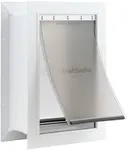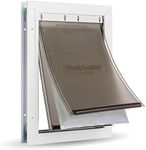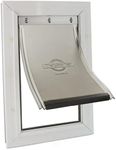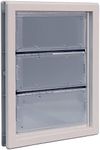Buying Guide for the Best Dog Doors
Choosing the right dog door for your furry friend can greatly enhance their comfort and independence, while also providing convenience for you. When selecting a dog door, it's important to consider various factors such as size, security, installation, and additional features. Understanding these key specifications will help you make an informed decision that best suits your dog's needs and your home's requirements.SizeSize is crucial when selecting a dog door because it needs to accommodate your dog's dimensions comfortably. Measure your dog's width and height to ensure they can pass through the door without difficulty. Dog doors typically come in small, medium, large, and extra-large sizes. Small sizes are suitable for toy breeds, medium for breeds like Beagles, large for breeds like Labradors, and extra-large for breeds like Great Danes. Choose a size that allows your dog to move through the door with ease, considering their current size and potential growth.
MaterialThe material of the dog door affects its durability and insulation properties. Common materials include plastic, aluminum, and vinyl. Plastic doors are lightweight and affordable but may not be as durable. Aluminum doors are sturdy and resistant to wear and tear, making them ideal for active dogs. Vinyl doors offer good insulation and flexibility. Consider your dog's activity level and the climate of your area when choosing the material. For instance, aluminum might be better for a high-energy dog, while vinyl could be preferable in colder climates.
SecuritySecurity is an important aspect to consider to prevent unwanted animals or intruders from entering your home. Some dog doors come with locking mechanisms or electronic controls that only allow access to pets wearing a specific collar tag. Manual locks are simple and effective, while electronic doors offer higher security but require batteries or power. Evaluate the security features based on your neighborhood's safety and your dog's habits. If you live in a high-risk area, an electronic door with advanced security might be the best choice.
InstallationInstallation can vary from simple to complex, depending on the type of dog door and the location where you plan to install it. Some doors are designed for easy DIY installation, while others may require professional help. Wall-mounted doors are more challenging to install compared to door-mounted ones. Consider your DIY skills and the structure of your home when choosing a dog door. If you're not comfortable with complex installations, opt for a model that offers straightforward installation instructions or seek professional assistance.
Weather ResistanceWeather resistance is important to ensure the dog door can withstand various weather conditions and provide insulation. Look for doors with weatherproof seals and flaps that prevent drafts, rain, and extreme temperatures from affecting your home. Some doors have double flaps or magnetic closures for enhanced insulation. If you live in an area with harsh weather, prioritize weather-resistant features to maintain comfort and energy efficiency in your home.
Additional FeaturesAdditional features can enhance the functionality and convenience of the dog door. These may include timers, remote controls, or sensors that detect your pet's presence. Some doors offer customizable access settings, allowing you to control when your dog can go in and out. Consider your lifestyle and your dog's habits when evaluating these features. If you have a busy schedule, a door with automated controls might be beneficial. If your dog has specific needs, look for features that cater to those requirements.
















